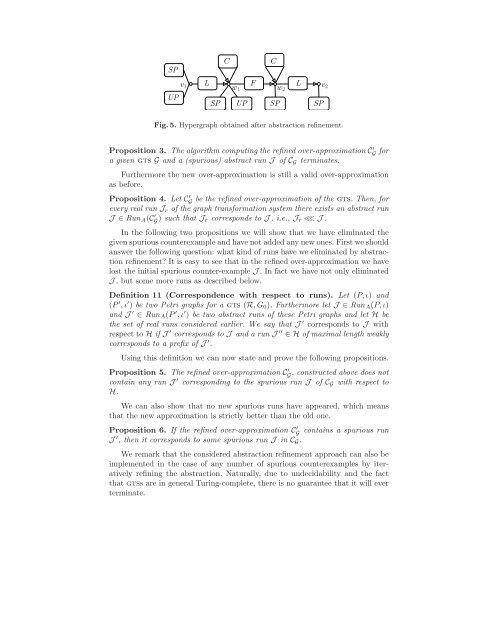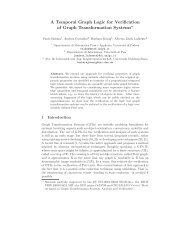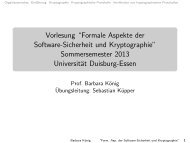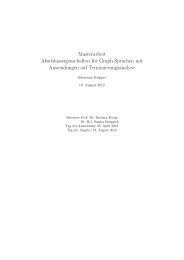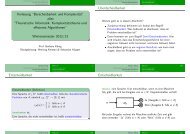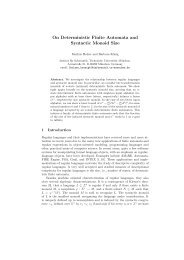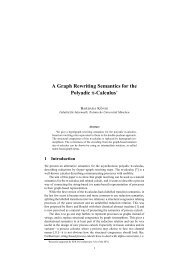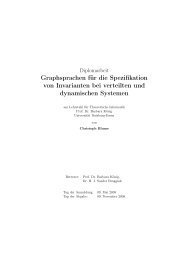Counterexample-guided Abstraction Refinement for the Analysis of ...
Counterexample-guided Abstraction Refinement for the Analysis of ...
Counterexample-guided Abstraction Refinement for the Analysis of ...
Create successful ePaper yourself
Turn your PDF publications into a flip-book with our unique Google optimized e-Paper software.
SPCv 1L F Lw 1 w v 22UPSP UP SP SPCFig. 5. Hypergraph obtained after abstraction refinement.Proposition 3. The algorithm computing <strong>the</strong> refined over-approximation C ′ G <strong>for</strong>a given gts G and a (spurious) abstract run J <strong>of</strong> C G terminates.Fur<strong>the</strong>rmore <strong>the</strong> new over-approximation is still a valid over-approximationas be<strong>for</strong>e.Proposition 4. Let C G ′ be <strong>the</strong> refined over-approximation <strong>of</strong> <strong>the</strong> gts. Then, <strong>for</strong>every real run J r <strong>of</strong> <strong>the</strong> graph trans<strong>for</strong>mation system <strong>the</strong>re exists an abstract runJ ∈ Run A (C G ′ ) such that J r corresponds to J , i.e., J r ≪ J .In <strong>the</strong> following two propositions we will show that we have eliminated <strong>the</strong>given spurious counterexample and have not added any new ones. First we shouldanswer <strong>the</strong> following question: what kind <strong>of</strong> runs have we eliminated by abstractionrefinement? It is easy to see that in <strong>the</strong> refined over-approximation we havelost <strong>the</strong> initial spurious counter-example J . In fact we have not only eliminatedJ , but some more runs as described below.Definition 11 (Correspondence with respect to runs). Let (P,ι) and(P ′ ,ι ′ ) be two Petri graphs <strong>for</strong> a gts (R,G 0 ). Fur<strong>the</strong>rmore let J ∈ Run A (P,ι)and J ′ ∈ Run A (P ′ ,ι ′ ) be two abstract runs <strong>of</strong> <strong>the</strong>se Petri graphs and let H be<strong>the</strong> set <strong>of</strong> real runs considered earlier. We say that J ′ corresponds to J withrespect to H if J ′ corresponds to J and a run J ′′ ∈ H <strong>of</strong> maximal length weaklycorresponds to a prefix <strong>of</strong> J ′ .Using this definition we can now state and prove <strong>the</strong> following propositions.Proposition 5. The refined over-approximation C G ′ , constructed above does notcontain any run J ′ corresponding to <strong>the</strong> spurious run J <strong>of</strong> C G with respect toH.We can also show that no new spurious runs have appeared, which meansthat <strong>the</strong> new approximation is strictly better than <strong>the</strong> old one.Proposition 6. If <strong>the</strong> refined over-approximation C G ′ contains a spurious runJ ′ , <strong>the</strong>n it corresponds to some spurious run J in C G .We remark that <strong>the</strong> considered abstraction refinement approach can also beimplemented in <strong>the</strong> case <strong>of</strong> any number <strong>of</strong> spurious counterexamples by iterativelyrefining <strong>the</strong> abstraction. Naturally, due to undecidability and <strong>the</strong> factthat gtss are in general Turing-complete, <strong>the</strong>re is no guarantee that it will everterminate.


